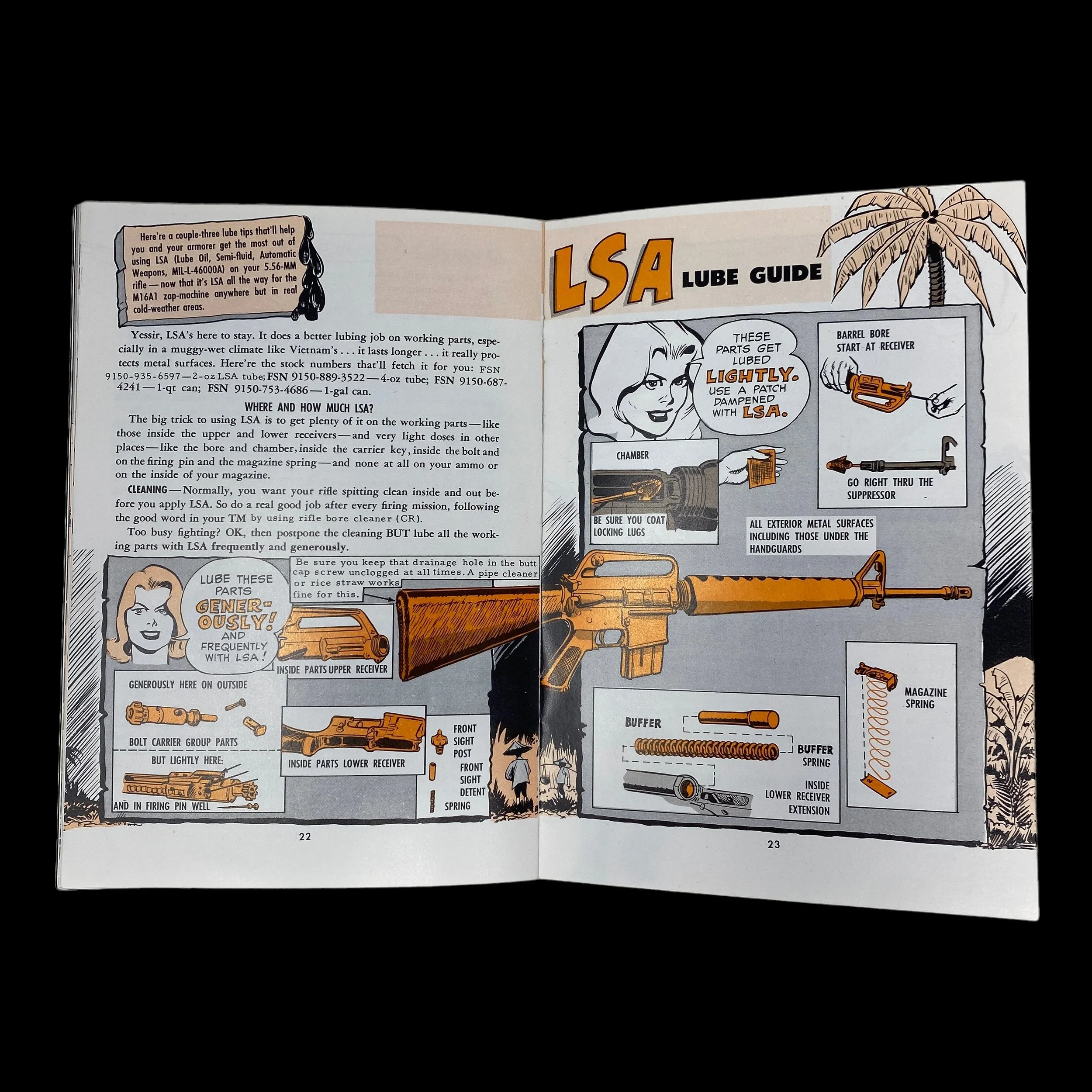RARE! 1969 Illustrative Manual “M16A1 RIFLE - OPERATION AND PREVENTATIVE MAINTENANCE” - HEADQUARTERS DEPARTMENT OF THE ARMY





















RARE! 1969 Illustrative Manual “M16A1 RIFLE - OPERATION AND PREVENTATIVE MAINTENANCE” - HEADQUARTERS DEPARTMENT OF THE ARMY
Comes with a hand-signed C.O.A.
This original and museum-grade Vietnam War artifact is a very unique and artistic pictorial manual made for U.S. soldiers during the Vietnam War. Titled “M16A1 RIFLE - OPERATION AND PREVENTATIVE MAINTENANCE” this manual was specially contracted by the HEADQUARTERS DEPARTMENT OF THE ARMY - WASHINGTON D.C. and made for soldiers to gather important information more visually.
Dated 1969 this visual manual is filled with the art of Will Eisner that extensivly details: how to disassemble the M16A1, how to unjam an M16A1, tips from other soldiers about the M16A1, semi and full-auto features, tools for the , M16A1, etc.
The Vietnam War, a protracted conflict that raged from 1955 to 1975, witnessed the deployment of various weapons, but none captured the essence of the era quite like the M16A1 rifle. Developed and adopted by the United States military during the early 1960s, the M16A1 quickly became an iconic symbol of the Vietnam War.
The M16A1's lineage can be traced back to the Armalite AR-15, a lightweight and innovative rifle designed by Eugene Stoner in the late 1950s. The U.S. military took an interest in the AR-15, leading to trials and modifications before officially adopting it as the M16 in 1963. The early version, known as the M16, faced teething issues in the jungles of Vietnam, necessitating improvements. Subsequently, the upgraded M16A1 was introduced in 1967, incorporating design changes to enhance reliability and address the concerns raised during its initial deployment.
The M16A1 featured several key characteristics that set it apart from its predecessors and other contemporary rifles. One of its defining features was its lightweight construction, utilizing advanced materials like aluminum alloys and plastics. This made the rifle significantly lighter than its counterparts, facilitating ease of use for soldiers operating in the dense jungles of Vietnam.
Another critical aspect of the M16A1 was its caliber. Chambered for the .223 Remington cartridge, the M16A1 boasted a smaller and lighter round compared to the traditional 7.62mm NATO ammunition. This not only reduced the weight that soldiers carried but also allowed for increased ammunition capacity, as the M16A1 could accommodate larger magazines.
The M16A1 was also a gas-operated, selective-fire rifle, providing soldiers with the flexibility to switch between semi-automatic and fully automatic firing modes. This adaptability proved advantageous in the unpredictable and close-quarters combat scenarios of the Vietnam War.
The introduction of the M16A1 significantly influenced the dynamics of warfare during the Vietnam conflict. Its lightweight design and smaller caliber provided American soldiers with a more maneuverable and agile weapon, well-suited for the guerrilla-style tactics employed by the Viet Cong. The fully automatic firing mode was particularly effective in close-quarter engagements, allowing soldiers to lay down suppressive fire in dense jungle environments.
However, the M16A1 was not without its controversies. The shift to a smaller caliber led to debates about the rifle's stopping power, with some soldiers expressing concerns about the effectiveness of the .223 Remington round in comparison to the larger 7.62mm NATO rounds used in previous rifles. Additionally, issues with the M16's maintenance and reliability during its early deployment tarnished its reputation, leading to a reevaluation and improvement process that birthed the M16A1.
Despite its initial challenges, the M16A1's legacy extends beyond the Vietnam War. The improvements made to the rifle not only addressed reliability issues but also set the stage for subsequent iterations, including the M16A2 and M4 carbine, which became standard-issue rifles for the U.S. military in later years. The M16A1's modular design and adaptability laid the foundation for the development of modern infantry weapons, emphasizing a balance between firepower, weight, and versatility.
The M16A1's journey from the jungles of Vietnam to its lasting impact on modern military firearms reflects its significance in the evolution of infantry weaponry. Born out of the crucible of conflict, the M16A1 overcame initial challenges to become an iconic symbol of the Vietnam War. Its lightweight design, smaller caliber, and adaptability not only shaped the outcome of battles during the 1960s and 1970s but also left an enduring legacy in the annals of military history. The M16A1 stands as a testament to the constant evolution and innovation required to meet the demands of ever-changing battlefield environments.